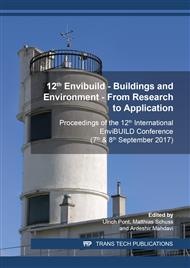p.361
p.369
p.374
p.385
p.393
p.401
p.411
p.419
p.428
Thermo-Hygral and Environmental Evaluation of Chosen Parts of an Ultra-Low-Energy Family Houses
Abstract:
The goal of this paper is to assess two ultra-low-energy family houses from thermo-physical aspects and environmental perspectives. Thermo – physical evaluation, done in two-dimensional PC software Area, has shown results that consent with the newest standards for designing critical details in two ultra-low-energy family houses. Both cases show correctness in design in regards to thermo-physical properties. Both critical spots – corners are well insulated with surface temperatures over 17°C, which indicates low risk of mold occurring. Most of the embodied energy is in roof construction with value of 3084 MJ in house A and 1943 MJ in house B. In terms of indicator of global warming potential, most emissions were calculated in bearing walls of house B (593 kgCO2eq/m2). From the acidification potential, the most emissions were determined in the roof construction B (1.02283 kgSO2eq/m2). It can be stated that financial expenses on groundwork and preparing polystyrene casing for a reinforced concrete slab is significantly higher (family house A) than for foundation insulated from the exterior side with extruded polystyrene (family house B).
Info:
Periodical:
Pages:
393-400
Citation:
Online since:
January 2019
Keywords:
Price:
Сopyright:
© 2019 Trans Tech Publications Ltd. All Rights Reserved
Share:
Citation:


